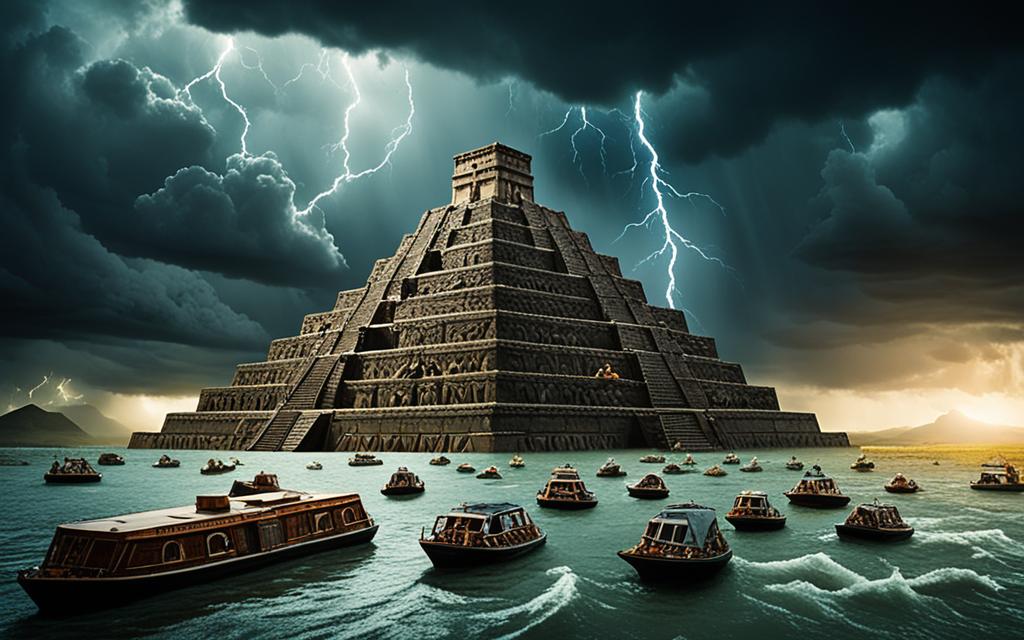Noah’s Ark is seen as an ancient story of God’s help and survival. It’s a key story of faith, saving, and following God’s will. Noah built a huge ark as told in the Bible, saving a few humans and many animals from a big flood. This flood was meant to clean the earth of evil.
American painter Edward Hicks showed how this story connects God’s promise to Noah with our strong spirit.
The Ark was huge, 300 cubits long, 50 wide, and 30 high. That’s about 440×72×43 feet. It was as big as some ancient wonders. But finding proof of such a massive ark is hard, even with deep research and searches.
Many experts argue about if the Ark really existed and could have survived a worldwide flood. The Durupinar Site in Turkey is one place where people looked for it.
The story of Noah’s Ark and the flood makes us think a lot. There are over 200 stories like this one around the world. They go back to old Mesopotamian myths, like the Epic of Gilgamesh. Noah’s Ark shows how history, myths, and stories of God have touched our hearts for so long.
Noah’s Ark and its Biblical Significance
Noah’s Ark is more than a story of survival. It’s filled with deep biblical significance. It talks about divine judgment, promise, and mercy. From the Genesis Flood narrative to Noah’s journey, it shares a powerful divine message. This message is about faith, obedience, and God’s care.
The Genesis Flood Narrative and its Message
In Genesis, the flood story shows God’s intervention against Earth’s corruption. It’s not just about punishment. It’s about starting fresh, where Noah’s following God marks a new deal between humans and God. The story shows God’s control over nature, with the rains stopping and starting as promised. This proves the detailed nature of God’s divine message.
God’s Covenant and Humanity’s Obedience
The Ark is more than a boat; it’s a symbol of life. Noah built it as told, showing his obedience and faith. This act of trust in God’s word is a key part of the story. It talks about life’s continuity and our duty under God’s covenant.
In the New Testament, Noah’s story connects to Christ’s redemption. The Ark’s journey mirrors the spiritual journey of believers. It shows the need to endure and hope through God’s grace.
Understanding Noah’s Ark reveals deep insights into God’s justice and the value of following God. This story is a key part of Judeo-Christian teachings. It reminds us of hope and renewal when faced with big challenges.
Global Deluge Accounts From Different Cultures
The idea of a global deluge is found in cultural narratives worldwide. It goes beyond borders and cultures. Each culture has its own story, showing local values and environmental conditions. For example, Mesopotamian myths, like the Epic of Gilgamesh, tell of heroism against divine wrath. This is different from other stories that focus on moral or spiritual growth.
Looking into flood myths shows how people see water as both a source of life and a force of destruction. These stories have been shared for generations. They teach moral lessons or explain natural events, showing how humans have dealt with nature’s power.

| Region | Key Figures | Narrative Focus |
|---|---|---|
| Mesopotamia | Gilgamesh, Ziusudra | Heroic survival and divine interaction |
| North America | Various tribal heroes | Spiritual renewal and world rebirth |
| Mesoamerica | Coxcox, Huracan | Cleansing of mankind and new beginnings |
| South America | Figures in Inca, Mapuche myths | Divine wrath and subsequent mercy |
| Asia | Yu the Great, Matsya (Vishnu avatar) | Protection from catastrophe, renewal |
| Europe | Diverse figures across myths | Moral restoration and climatic explanation |
| Oceania | Stories like Tiddalik | Environmental balance and life lessons |
Looking at these stories of global deluge from around the world, we see a common theme. Yet, the details and meanings vary a lot. Some stories focus on destruction, while others teach and uplift. This shows our shared human experience with natural disasters and how we try to make sense of them.
Understanding the Dimensions and Design of the Ark
The story of Noah’s Ark is a key part of ancient myths and a great example in architectural comparisons. The ark’s size, measured in cubits, shows how ancient people planned and built with great care. Today, we see that the ark’s size was not just big enough to hold all the animals and people. It was also built to stay stable and float well in the water.
Comparisons with Ancient Structures
The ark dimensions are interesting when compared to other old buildings. For example, the Ark was bigger than the Greek triremes and the big Chinese treasure ships. It was 300 cubits long, 50 cubits wide, and 30 cubits high, which is about 450 feet by 75 feet by 45 feet. This size was chosen to make the most of the space and keep it afloat.
A study in 1993 by Dr. Seon Won Hong in Korea looked into how seaworthy the ark was. They found that the ark could handle waves up to 100 feet high. This was important for surviving the big flood mentioned in the Bible.
The Symbolism of the Ark’s Measurements
The size of the Ark also has deep meanings. Scholars believe it was like a small model of the universe, as seen by the ancient people. The Ark’s size was not just for carrying animals and people. It also had a spiritual meaning, showing how it was connected to the universe and divine care.
In the end, comparing Noah’s Ark with other old buildings helps us understand its design better. It was not just a boat but also a symbol of ancient engineering skill and spiritual thought.
noahs ark: A Convergence of Myths and History
The story of Noah’s Ark is more than just a biblical tale. It’s a blend of ancient myths and deep historical roots. This story has changed a lot over time, influenced by stories from Mesopotamia and cultural exchanges found in history and archaeology.
From Mesopotamian Myths to Biblical Stories
Before the biblical story, Mesopotamian texts told of massive floods. These stories helped ancient societies make sense of natural disasters. Flood myths were around long before the biblical version, showing a shared human experience of floods.
These stories, passed down and changed over time, show a rich history of myths. They slowly became part of our understanding of civilizations hit hard by nature.
The Epic of Gilgamesh and its Relation to Noah’s Narrative
The Epic of Gilgamesh is one of the oldest stories we have. It tells a flood story very similar to Noah’s Ark. The story of Utnapishtim, who built a boat like Noah, is especially interesting.
These stories show how stories moved through time and places. They also show how humans have always tried to make sense of big disasters. These stories give us warnings and wisdom for the future.
Today, the story of Noah’s Ark helps us understand our past in a new way. It combines history, literature, and mythology.
The stories of floods are not just myths or history. They make us think about culture and religion. Mount Ararat, where Noah’s Ark landed, is a key spot for archaeologists and historians.
They look for evidence of the Ark and study how humans and the environment changed together.
| Evidence Type | Description | Impact on Historical Narrative |
|---|---|---|
| Linguistic Parallels | Close linguistic connections between the Ark narratives across different cultures. | Supports theories of intercultural exchanges and shared mythological themes. |
| Archaeological Finds | Artifacts and soil samples from Mount Ararat showing signs of ancient human activity. | Emphasizes the historical significance of the region in biblical and pre-biblical times. |
| Comparative Mythology | Analysis of flood myths across different cultures revealing common themes and variations. | Highlights the universality and adaptability of flood myths in human civilization. |
Archaeology, literature, and mythology come together to deepen our understanding of stories like Noah’s Ark. They show how different fields help us see human history more clearly.
Archaeological Pursuits for the Ark’s Remains
The search for Noah’s Ark remains has drawn many, mixing science with history and faith. Despite lots of searching, we haven’t found clear proof yet. This has led to a lively debate among experts, historians, and those who love archaeology.
Some places stand out as key spots in this search. Mount Ararat is often talked about because of its history and stories. But, there are other places like Mount Cudi near Cizre, Turkey, and spots in Iran. Each has its own history and geography that support its claim.
| Location | Claims | Skeptical Views |
|---|---|---|
| Mount Ararat | Traditional site linked to numerous alleged sightings. | Lack of physical evidence; geological indications suggest post-Flood volcanic activity. |
| Mount Cudi, Turkey | Historical texts and local lore suggest it as the landing site. | Geographical inconsistencies with biblical descriptions. |
| Various Sites in Iran | Alternative theories based on ancient maps and texts. | Relatively unexplored, making verification difficult. |
These searches bring up more questions than answers. The debate over the evidence is deep, influenced by how we interpret ancient texts and modern science. Without clear proof, the mystery of Noah’s Ark remains keeps us guessing and talking.
The search for Noah’s Ark faces big challenges. For example, wooden structures from so long ago wouldn’t likely survive today. Some experts say even if the Ark landed on these mountains, nothing would be left to prove it.
Even if we don’t find Noah’s Ark, the search itself teaches us a lot. It helps us understand ancient stories and how they connect with the world around us. Every exploration helps us learn more about early humans and their views on the world.
The Survival Story of Animals in the Ark
Noah’s Ark is more than a story of human bravery. It’s also a tale of animal survival during a massive flood. The Ark was a safe place for many life forms, helping them to survive the flood.
Feasibility Studies on Animal Livelihood During the Deluge
Looking into how animals could live on the Ark is fascinating. Scientists study how to keep different animals alive for 150 days of flood. They found that a few people could take care of about 16,000 animals by managing food and waste well.
After the flood, animals started eating meat, which changed their diet and behavior. This shows how animals adapted to their new environment after the flood.
Natural Preservation and Species Continuation
The Ark was key in saving many species. It had different levels for various animals, from small birds to big mammals. The Ark likely had natural light and air to keep the animals healthy.
Only seven pairs of clean animals were saved, but many mammals survived the flood. This helped many ecosystems recover.
The Ark had smart designs to keep animals safe and healthy. It had special ways to keep diseases away and manage animal waste. This was important for keeping the animals alive and healthy inside the Ark.

Scientific Scrutiny of the Ark and the Great Flood
Scientists study the Earth’s layers to find proof of a massive flood like the one in the Bible. They look for signs of such an event but often come up short. This makes us wonder if the flood was really worldwide and if it matches the story of Noah.
Examining Geological Evidence for a Massive Flood Event
There are many stories of floods in the Earth’s history, but not all of them suggest a flood that covered the whole planet. Scientists have looked deeply into the Earth’s layers and haven’t found proof of a global flood like Noah’s. Instead, they think most floods were local or in certain areas. This helps us understand how ancient stories might have been influenced by real floods.
Assessing the Possibility of a Real Noah’s Ark
Scientists also question if the Ark could have been built as described in the Bible. Building such a huge ship was impossible with ancient technology. Ships back then were much smaller than the Ark. Also, keeping all the animals safe and healthy would be very hard without modern tools.
So, without proof, the story of Noah seems more like a story than a true event.
Source Links
- https://en.wikipedia.org/wiki/Noah’s_Ark
- https://www.biblestudytools.com/bible-stories/noah-s-ark.html
- https://www.holylandsite.com/noah-ark-location
- https://www.biblestudytools.com/bible-study/topical-studies/what-is-noahs-ark-and-what-does-it-teach-about-who-god-is.html
- https://www.christianity.com/wiki/bible/meaning-and-significance-of-noahs-ark.html
- https://en.wikipedia.org/wiki/List_of_flood_myths
- https://arkencounter.com/flood/myths/
- https://www.icr.org/article/why-does-nearly-every-culture-have-tradition-globa/
- https://answersingenesis.org/noahs-ark/what-did-noahs-ark-look-like/
- https://answersingenesis.org/noahs-ark/thinking-outside-the-box/
- https://christianpure.com/learn/noahs-ark-dimensions/
- https://visitturkey.in/noahs-ark-a-journey-through-history-myth-and-discovery/
- https://www.pbs.org/wgbh/nova/bible/flood.html
- https://www.bookey.app/book/the-ark-before-noah
- https://digitalcommons.cedarville.edu/cgi/viewcontent.cgi?article=1460&context=icc_proceedings
- https://www.anonymoushackers.net/random/noahs-ark-found-in-turkey-a-remarkable-discovery/
- https://arkencounter.com/noahs-ark/story/
- https://answersingenesis.org/noahs-ark/what-happened-to-animals-after-noahs-ark/
- https://answersingenesis.org/noahs-ark/caring-for-the-animals-on-the-ark/
- https://ncse.ngo/impossible-voyage-noahs-ark
- https://spot.colorado.edu/~tooley/ChatGPT_Defending_Biblical_Miracles.html

